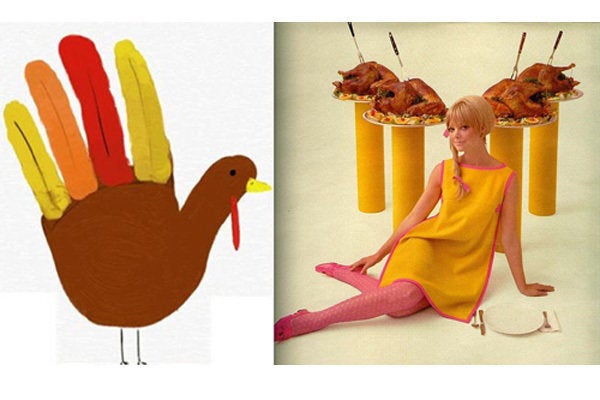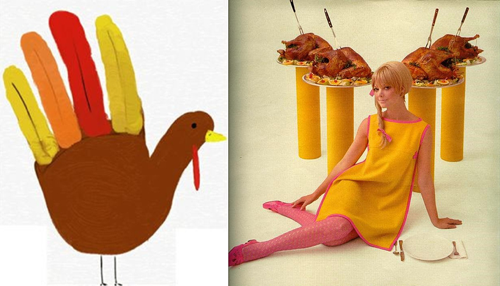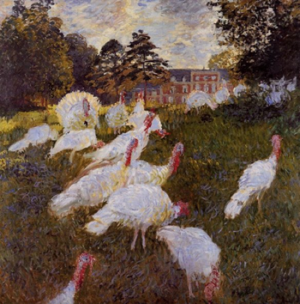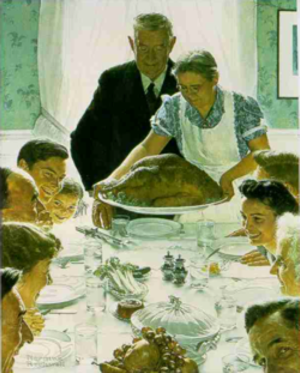
On July 20, 1969 a turkey landed on the moon. It was unaware of the historical importance of the occasion, having recently been reduced into a tiny tinfoil packet-- but it was there, right there, orbiting along with Neil and Buzz and the American flag high above Earth's atmosphere. The first meal our favorite intrepid astronauts ate upon their momentous lunar touchdown was a mushy turkey dinner complete with all the fixings.
While the moon's exploration was one giant leap for mankind, turkeys weren't particularly impressed by the news of this accomplishment... and why should they be? Fossil evidence indicates that turkeys roamed North America as long as 10 million years ago. By 1969 they must have had a pretty broad perspective on this whole forward progress thing that us newbie humans still can't seem to quit obsessing about. Thank goodness for all those millions of years of evolution they had under their wings before we came along. I wonder where we would be today without the benefit of the turkey, whose constant countenance has inspired some of our greatest artists and political thinkers while simultaneously sustaining our survival with its fleshly sacrifice. The noble turkey is a muse, a martyr and the tasty main mascot of our modern holiday rituals.

The turkey as creative inspiration moved French Impressionist Claude Monet to pick up his paintbrush in1876. His resulting work was shown at the third Impressionist exhibition to mixed critical response- some thought it was just the right thing to dress up a dining room wall, while others disparaged his choice of subject as ridiculous. Today the painting hangs in the Musee d'Orsay in Paris, daring only the boldest ignoramus to snicker.

Turkeys by Claude Monet
In 1943 Norman Rockwell also rendered the turkey as Art in one of a series of paintings called "The Four Freedoms," which were created as an effort to promote Franklin D. Roosevelt's 1941 State of the Union Address to Congress. Roosevelt spoke of his vision for a better way of life through what he considered the four essential human freedoms: Freedom to Worship, Freedom from Fear, Freedom from Want and Freedom of Speech. Rockwell's representation of the noble turkey in Freedom from Want was used with great success to enhance feelings of family values, unity and patriotism at a time when these sentiments were on the wane in America.

Freedom from Want by Norman Rockwell
Founding Father Benjamin Franklin had heaps of admiration for turkeys. In a letter to his daughter Sally in 1784 he criticized the choice of the Eagle as our U.S. national bird, suggesting the turkey was a better alternative: "I am on this account not displeased that the Figure is not known as a Bald Eagle, but looks more like a Turkey. For the truth, the turkey is in comparison a much more respectable bird, and withal a true original Native of America...He is besides, though a little vain and silly, a bird of courage, and would not hesitate to attack a grenadier of the British Guards who should presume to invade his farm yard with a red coat on."
Though Franklin's earnest praise must have been some consolation, it's been no walk in the park for the "Bird of Courage" as runner up to the crown for national bird. While the Bald Eagle enjoys its vaunted status as a protected species, only one turkey per year receives a presidential pardon to go live out the rest of its days in the happiest place on earth, Disneyland. Millions and millions of less fortunate turkeys are currently awaiting basting for the holidays. The turkey industry is booming in America and along with this reality enters the issue of factory farming. Since the 1920's turkeys have been selectively bred for larger size and greater breast width, which culminated by 1950 into the most common varieties available today, the broad breasted bronze and the broad breasted white turkey. Though these breeds can be produced in a cost- and time-effective manner, they also come with drawbacks: they are unable to mate naturally to produce fertile eggs and require artificial insemination to reproduce. Factory-farmed turkeys are efficient-centric without consideration for long-term genetic viability or flavor. The race to mass manufacture super turkeys for our festive consumption has created an odd amalgam of progress and tradition.

Factory farmed turkeys
If you find yourself yearning for more of the taste of tradition, consider purchasing a heritage turkey instead of a factory-farmed one this holiday season. Heritage turkeys are historic breeds raised in range based production systems instead of cages. They retain their natural fertility and have a slow growth rate. This allows the turkey to develop healthy organs and a strong skeletal structure before building muscle mass. These turkeys have more flavorful meat and are treated more humanely that their factory counterparts. The heritage turkey's stronger bones yield wishbones with better karma to break for our dreams, which seems like a good deal for both us and one of our favorite symbols of American tradition.

Heritage Turkeys: Bourbon Red, Royal Palm, White Midget, Slate